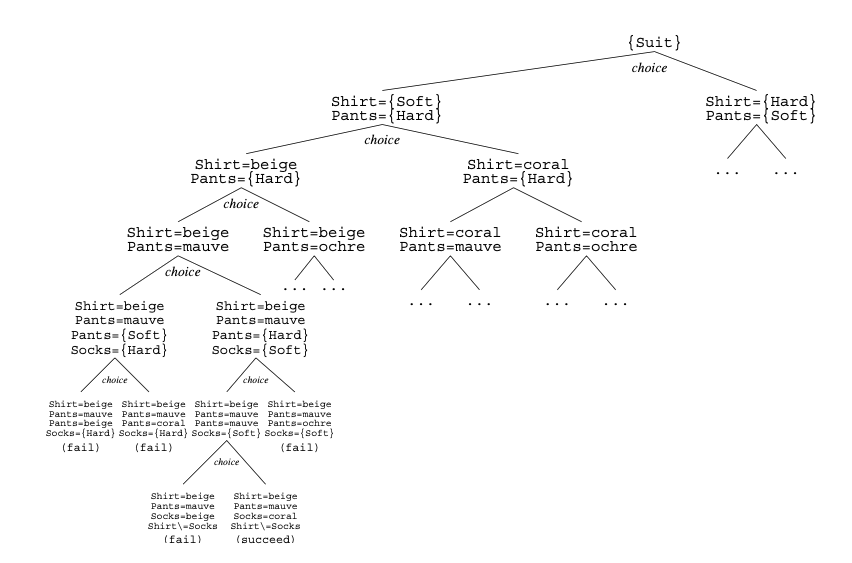逻辑编程模型同样属于声明式范畴, 但与普通的declarative model不同, 它引入了一种完全不同的编码范式.
逻辑编程模型的核心目标是在一个搜索空间(计算空间/数据空间)中, 找到满足给定约束条件的一组数据.

例如, 假设有若干件衣服, 裤子及其他装饰品, 需搜索(衣服, 裤子, 装饰)的元组, 约束条件为不能出现红配蓝, 且不能同时出现长袖, 短裤和领结, 目标是得到所有可能的搭配😅.
在逻辑编程模型中, 我们只需指定搜索空间, 约束条件和目标, 具体的搜索与回溯一般由内置的推理引擎(inference engine)执行.
此外, 还有一种类似的模型称为关系模型, 两者核心均为指定约束条件, 在给定搜索空间中进行搜索. 不同之处在于, 关系模型侧重于数据管理与查询, 常见于数据库领域;而逻辑编程模型更关注逻辑推理, 相较关系模型更为通用. 鉴于两者内在逻辑相近, 后续内容中不再特别区分.
Oz2中的relational Model¶
Oz2 为了支持relational model, 引入了以下三种特性.
- choice用来指定一个变量或一组变量能够取的值, 即搜索空间. 这个例子中Shirt, Pants, Socks为三个变量, 而我们用
choice定义了搜索空间. - 设定约束可以通过显式使用fail, 或者直接报错来设定. 例子中使用
fail设定了Shirt和Socks的颜色不能相同. - 最终我们调用内置的
SolveAll函数来得到所有满足约束的数据tuple.
1 2 3 4 5 6 7 8 9 10 11 12 13 14 15 16 17 18 19 20 21 22 23 24 25 26 27 28 29 30 31 32 33 34fun {Soft} % choice代表返回值要么是beige, 要么是coral choice beige [] coral end end fun {Hard} % 同理 choice mauve [] ochre end end proc {Contrast C1 C2} % 代表C1, C2的可选范围 choice C1 = {Soft} C2 = {Hard} [] C1 = {Hard} C2 = {Soft} end end fun {Suit} Shirt Pants Socks in % 定义了搜索空间 {Contrast Shirt Pants} {Contrast Pants Socks} % 这里使用fail, 显式对搜索进行剪枝 if Shirt == Socks then fail end suit(Shirt Pants Socks) end % 调用SolveAll进行求解 {Browse {SolveAll Suit}}
Oz2中搜索穿搭组合的例子

本质上Oz2中的执行会形成一颗搜索树, 从根节点开始, 依次搜索Shirt, Pants, Socks的可能值, 遇到fail就回溯. 直到遍历整棵树, 得到所有的可行解.
这里问题建模的方式, 和搜索的先后顺序会影响执行效率, 但不影响正确性, 所以这里就不再展开.
Sql中的relational Model¶
Sql支持relational model, 可以对同一个问题进行建模. 同样的问题在sql中是这样的.
1 2 3 4 5 6 7 8 9 10 11 12 13 14 15 16 17 18 19 20 21 22 23 24 25 26 27 28 29 30 31 32 33 34 35 36 37 38-- 准备数据 CREATE TABLE colors ( color_name VARCHAR(50) PRIMARY KEY, color_category VARCHAR(10) CHECK (color_category IN ('Hard', 'Soft')) ); INSERT INTO colors (color_name, color_category) VALUES ('Mauve', 'Hard'), ('Ochre', 'Hard'), ('Beige', 'Soft'), ('Coral', 'Soft'); SELECT -- "solveAll" Shirt.color_name AS shirt_color, Pants.color_name AS pants_color, Socks.color_name AS socks_color, FROM -- 指定搜索空间 colors Shirt CROSS JOIN colors Pants CROSS JOIN colors Socks WHERE -- 指定约束条件 ( (Shirt.color_category = "Soft" AND Pants.color_category = "Hard") OR (Shirt.color_category = "Hard" AND Pants.color_category = "Soft") ) AND ( (Pants.color_category = "Soft" AND Socks.color_category = "Hard") OR (Pants.color_category = "Hard" AND Socks.color_category = "Soft") ) AND Shirt.color_name <> Socks.color_name
可以看出Sql中也有描述搜索空间, 指定约束条件和SolveAll. 只不过相比于Oz2, Sql更适合用来检索大量结构化数据. 而Oz2更适合用来建模一些组合问题.
Prolog中的logic Programming Model¶
Prolog(Programming in Logic)是一种基于逻辑编程的声明式编程语言. Prolog诞生于上世纪70年代, 并一直作为逻辑编程和关系模型的标杆而存在. 和其他声明式语言一样, prolog也通过描述"what"而不是"how"来解决问题.
关于prolog的语法可以参考这篇cheatsheet.
其基本构成要素有:
• 事实(Facts): 描述确定的关系, 如 parent(tom, bob)., parent(alice, tom).
• 规则(Rules): 定义推理逻辑, 如 grandparent(X,Z) :- parent(X,Y), parent(Y,Z).
• 查询(Queries): 提出问题, 如 ?- grandparent(alice, bob).
.结尾代表语句结束.:-代表后续语句定义前面的predicate.;代表or,,代表and.- 大写字母开头代表变量.
Prolog有一个代表性的feature, 叫做unification. 即predicate(类似于函数)既能判定真假, 也能够用来求变量的可能值, 它代表一种逻辑关系.
1 2 3 4 5 6append([1, 2], [3, 4], [1, 2, 3, 4]) % True append([1, 2], [5], L) % L == [1, 2, 5] append(L, [3, 4], [1, 2, 3, 4]) % L == [1, 2] append([1, 2, 3], M, [1, 2, 3, 4]) % M = [4] append([1, 2], [3], N) % N = [1, 2, 3] append(P, Q, [1,2,3]) % P = [] Q = [1,2,3]; P = [1] Q = [2, 3]; ...
append(M,N,L)代表三个list: M,N,L之间的关系, M+N==L
譬如在上述例子中, append(M,N,L)
- 可以给定 M, N, L, 判定关系是否成立
- 可以给定 M, N, 计算L
- 可以给定 N, L, 计算M
- 甚至可以给定 L, 计算所有(M, N)的可能性
我们试着在prolog中, 重新实现一遍上述求穿搭的例子
1 2 3 4 5 6 7 8 9 10 11 12 13 14 15 16 17 18 19 20 21 22 23 24 25 26 27 28 29 30 31 32 33 34 35 36 37 38 39 40 41 42 43 44 45:suit.pl % 定义soft colors soft_color(beige). soft_color(coral). % 定义hard colors hard_color(mauve). hard_color(ochre). % 定义判定不同种类的颜色的predicate different_color_types(Color1, Color2) :- (soft_color(Color1), hard_color(Color2)); (hard_color(Color1), soft_color(Color2)). % 定义判断不同颜色的predicate different_colors(Color1, Color2) :- Color1 \= Color2. % Main predicate valid_combination(Shirt, Pants, Socks) :- % 设定搜索空间 (soft_color(Shirt); hard_color(Shirt)), (soft_color(Pants); hard_color(Pants)), (soft_color(Socks); hard_color(Socks)), % 设定约束 different_color_types(Shirt, Pants), % Constraint 1 different_color_types(Pants, Socks), % Constraint 2 different_colors(Shirt, Socks). % Constraint 3 % 求解 find_all_combinations :- findall([Shirt, Pants, Socks], valid_combination(Shirt, Pants, Socks), Solutions), write('All valid color combinations:'), nl, print_solutions(Solutions). % 定义打印结果的predicate print_solutions([]). print_solutions([[Shirt, Pants, Socks]|Rest]) :- format('Shirt: ~w, Pants: ~w, Socks: ~w~n', [Shirt, Pants, Socks]), print_solutions(Rest). .
Prolog是一门有趣且实用的语言, 曾在人工智能, 专家系统, 自然语言处理, 数据库查询和符号推理等领域取得出色表现, 值得深入了解.
什么时候使用logic Programming Model?¶
毫无疑问, 在解决搜索问题时, 使用逻辑编程模型是最合适的. 虽然该模型也能用于编写通用代码, 但这并非其设计初衷.
目前原生直接支持逻辑变成或关系模型的语言并不多, 但主流语言通常会提供相关的三方包或库, 例如Python中的kanren, Java中的LogicNG等等.
在业务中遇到搜索问题时, 可以尝试采用该模型, 而对于大量结构化数据的查询, 则应优先使用数据库及SQL(或其封装).